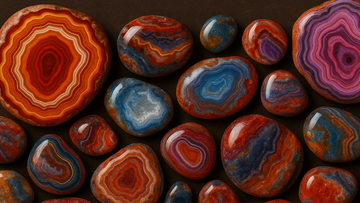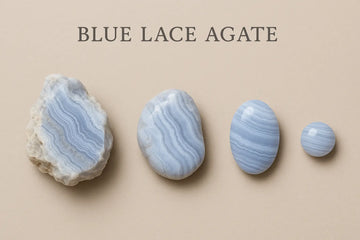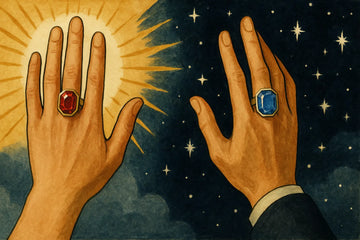Let’s get down to it. The problem with modern humanity is a catastrophic lack of stones. Not the kind you trip over in the yard, blind-drunk on a Tuesday night. No. I’m talking about real stones. Stones with a history of violence and cosmic insanity. Stones that have seen things you wouldn’t believe. Stones like Agate.
The Myth: A River God’s Eyeball
The story goes that some Greek fool, probably high on fermented goat’s milk, stumbled along the Achates River and picked up a stone with a perfect, unblinking eye staring back at him. He thought it was a gift from the river god. What he’d actually found was the planet’s first-ever Rorschach test. He saw a god. A Siamese warrior would have seen a weapon. A Bedouin trader would have seen currency. A New Age crystal healer in Sedona would see a tool to “align his chakras,” whatever the hell that means.
That’s the first truth of Agate: It doesn’t mean anything until you project your own madness onto it. It’s a blank slate, a silent partner in crime. It’s the perfect gem for our twisted species because it is whatever we need it to be: a shield, a weapon, a prayer, a paperweight. Its entire history is a wild, chaotic brawl of conflicting narratives.
A Fever-Dream of History: From War Clubs to Holy Books
Don’t let anyone tell you history is clean. It’s a blood-soaked, paranoid nightmare, and Agate has been there for all of it.
In ancient Persia, they weren’t dabbing lavender oil on this stone. They were carving it into rings for kings who knew their power was built on fear. They’d stamp their seal into hot wax on a death warrant, the Agate biting deep, a permanent mark of finality. The stone was hard, unforgiving. Just like the king.
Then you have the Minoans on Crete. A civilization that vanished in a cloud of volcanic ash and mystery. They left behind these intricate Agate seals so finely carved you need a magnifying glass to see the damn bulls and gods. Why? What were they trying to prove? That they could contain immense, violent power in something the size of a thumbnail? It reeks of obsession. It’s the kind of detail that keeps archaeologists drinking late into the night.
Fast forward to the Islamic Golden Age. They’re fixing Agate into daggers. Not for cutting, but for *meaning*. The curve of the blade, the depth of the blue—it was all a language. A language of power and paradise. They’d engrave verses from the Quran onto Agate cameos, turning geology into scripture. Try to get your head around that. They believed God’s own word could be carried in a stone formed in the belly of a volcano.
And the East? Don’t get me started. In India, they were throwing Agate into mortars and pounding it into powder to eat. They believed it could cool the blood, calm the rage. A direct, chemical intervention into the human psyche. In Thailand and Burma, they were burying it with the dead as a toll for the spirit world. In China, it was the ultimate symbol of the unshakable Middle Kingdom, a kingdom that, of course, shook constantly. The irony was lost on them. The Agate knew.
The Hunt: Bad Luck and Worse Digging
Which brings me to the desert. My hands are raw. My back is a symphony of pain. I’d been convinced by a sun-leathered prospector named Cactus Jim—a man who likely had no legal name—that a certain wash was “lousy with fire agate.” Three hours of digging under the sadistic sun had yielded two scorpions, a rusty can, and a profound sense of existential failure.
This is the second great truth of Agate: It is a liar. It promises wealth but demands suffering. The notion that you can just “dig up agate in your yard” is a fantasy sold to tourists. The math is ugly. The chance of a random cavity in the earth actually containing gem-quality Agate is less than the chance of a politician telling the truth. It’s like finding one specific, sober person in the midst of Mardi Gras. It’s not going to happen.
The real stuff is wrestled from the earth by madmen and professionals. The mines in Brazil are vast, terrifying pits. In Montana, the ‘agate dogs’—the hardmen who hunt this stone—work riverbeds for years to find a few good nodules. They don’t talk about chakras. They talk about luck, muscle, and silence. This isn’t a hobby. It’s a compulsion.
But here’s the beautiful, twisted, modern miracle: we don’t have to rip it from the earth’s guts anymore. Some brilliant, half-crazed alchemist in a lab coat finally cracked the code. They learned how to take the same simple sh*t—silica and water—and pressure-cook it into the same swirling, banded, cryptic perfection. They can now grow the madness in a vacuum chamber, replicating a million years of geological violence in a matter of weeks. It’s the same cosmic joke, just told faster and without the bloodstains. You get the same insane, eye-of-the-god pattern without the existential guilt. It’s not a fake. It’s a clone. A photocopy of chaos. And it’s goddamn brilliant.
The Payoff: Wearing the Chaos
So why, after all this, would you want a piece of this madness on your wrist?
Forget the pamphlets. Forget the healing crystals and the positive energy. That’s wallpaper for the brain.
You wear an Agate bracelet because it is a trophy. It is a piece of the earth’s brutal, beautiful, indifferent history. It is a fossilized reminder that the world is wild and strange and doesn’t care about your problems.
When you look down at that banded, swirling pattern, you’re not looking at a “ calming stone.” You’re looking at a time machine. You’re looking at volcanic fury, at mineral-rich water dripping for a million years, at the hands of every king, warrior, and mad artist who ever held it.
It’s a piece of the real world, the hard world, the world that exists without your permission. And strapping it to your wrist is a statement. It’s a promise to yourself that you haven’t gone completely soft. That you still recognize real power when you see it. That somewhere, deep in your soul, you’re still a little bit mad, too.
That’s the deal. Buy the ticket, take the ride.
Order yours now. Before you lose your nerve.




